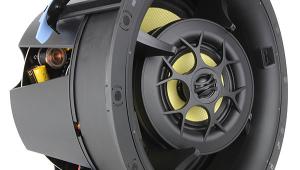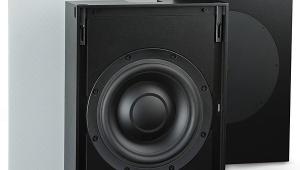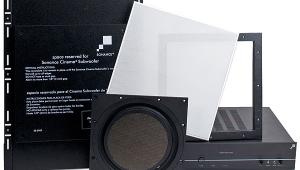PSB CustomSound CHS80 Speaker System
To the casual observer, the home theater world probably looks relatively homogenous. After all, home theater isn't big enough, established enough, or varied enough to break itself into endless sub-categories yet, is it? The truth is, categorization has been a part of home theater from the beginning, and the gap between its two main sub-categories—let's call them conventional products and custom-install products—is wide. When it comes to speakers, the gap is only getting wider.

Open any audio magazine, and what kinds of speakers do you see? Pages of conventional towers, bookshelf models, and the occasional on-wall. Walk into almost any custom theater space, and what speakers do you see? None. Why? Because they're hidden away; roughly 95 percent of the time, they're in-wall models. To say that in-walls have progressed is a serious understatement, but there are still those (myself included) who aren't ready to hand over all home theater duties to in-walls, especially the duties of the front and center speakers and sub. Still, the fact remains that most people with custom installations don't want to see their speakers, don't want them taking up space, and will accept compromised performance to get that.
So, how do you get the best of both worlds? One solution is to fuse conventional design (build a large, self-contained speaker) and custom-install design (tailor that speaker for in-cabinet installation). PSB's new CustomSound line embraces this concept and features the in-cabinet CHS80 L/C/R model and the CHS212 subwoofer. I added four CW383 in-walls (one of four in-wall models in the line so far) for a 7.1-channel system that is as visually discreet as it is sonically impressive.
Crossovers and Cabinets
PSB's philosophy for the in-cabinet offerings is simple: Take the performance of their highly regarded Platinum Series speakers and SubSonic subs and modify the crossovers for in-cabinet use while minimally compromising the sound. After all, you can't simply stuff any speaker into a cabinet and expect it to sound good. Tweaking the speaker, and often the cabinet, is necessary. The CustomSound in-cabinet models have switchable crossover adjustments for the bass/midrange—primarily to account for boundary effects inside the cabinet—and the treble, which makes it easier to tailor the speaker for the mounting space, including compensating for high-frequency loss due to placement behind a perforated screen.
To test this system, I mounted two CHS80s in the speaker cubbyholes on both sides of an ImageCrafters cabinet and one in the central cavity behind a Stewart GrayHawk screen, atop the CHS212 subwoofer. PSB lined the left and right speaker enclosures with fiberglass insulation to further tame cabinet reflections (crossover modifications can't do everything). I placed the CW383s in columns designed to simulate the interior space between two standard studs.
The CHS80 is a modified version of the excellent Platinum T8, and I was pleased to hear that it maintains virtually all of its predecessor's fidelity with two-channel music, despite being tucked away in a cabinet. I listened first for bass performance and was impressed by the CHS80's tight, controlled lower frequencies. Boomy bass is an Achilles heel of in-cabinet placements, and PSB has obviously addressed that. The CHS80 is rated to 32 hertz. I never felt that bass extension was lacking, but the CHS212 subwoofer is certainly musical enough that you could add it to the two-channel mix if you wanted to. The T8's deadly accurate, natural midrange response is clearly preserved in the cabinet-mounted CHS80.
Bloated vocals are another concern with in-cabinet speakers, but not here. Muddy Waters was no chestier than he usually is in His Best 1947–1955 (Chess), and his slide-guitar work, combined with Little Walters' furious harmonica bursts, proved that the upper frequencies also survived the metamorphosis exceptionally well.
The impressiveness of the CHS80's midrange and high frequencies only increased with high-resolution material. The dynamic attack and occasional fevered pitch of the clarinet throughout Bucky Pizzarelli's Swing Live SACD (Chesky) were as immediate and forceful as ever, but the instrument was also smooth, natural, and well balanced. I'm not big on in-walls with music, but I give credit where it's due, and the CW383 clearly deserves some. Like most any in-wall or surround speaker, the CW383 is more comfortable when reproducing a conventional surround mix that relegates the surround channels to a more-ambient role. However, even with "in the band" mixes, the CW383 demonstrated that it can handle music far better than many of its kind, as it did with the Grateful Dead's American Beauty. This mix puts guitars, vocals, and more in the surround channels, and the CW383 responded admirably with a full-bodied voice and a composed character that sounded more like a quality bookshelf model.
Movie Dynamos
As well as this system handles music, movies will be its main fare. I'm not used to hearing the forceful and dynamic character that this system delivered with movie soundtracks from speakers you can't see. I've yet to hear this kind of front-stage performance from even the best in-walls in the business.

Hollywood packs far too much into the center channel for most any in-wall to handle comfortably, and this is where the CHS80 especially ingratiated itself to me. I like large, three-way center speakers, and the CHS80 puts many of the standard, horizontally aligned models in their place. Even though the ImageCrafters cabinet has a large center cavity and the screen was a microperforated GrayHawk, the CHS80 still had the significant handicaps of being in an enclosure behind a screen. Yet, it was clearly successful in minimizing boundary colorations, as well as the high-frequency anomalies that result from slap echoes and other screen issues. You've done something special when you can put a center speaker in an enclosure behind a screen and still get it to perform better than many center speakers in open space—and PSB has achieved just that with the CHS80.
As it's also mounted in the center cavity, the CHS212 subwoofer faced similar challenges—although screen interaction isn't as much of a concern with low frequencies. Enclosure effects are, though; and, like the CHS80, the CHS212 did an excellent job of avoiding the boominess and bloating caused by adjacent boundaries. Its dual 12-inch drivers mustered up more than enough SPL for our listening room, but it was sharp and clean throughout, with a big attack and smooth, natural decay for large events like the artillery fire in Band of Brothers or the trampling of mammoth feet in The Return of the King.
I know that the writing is probably on the wall (or is it in the wall?) for conventional, freestanding loudspeakers. However, until someone proves otherwise, conventional speakers will remain the best sounding speakers there are. PSB's CustomSound line is proof that the best of both worlds—top-shelf performance and uncompromised aesthetics—can be brought together. Both the CHS80 and CHS212 are strong, dynamic, and highly musical, and the CW383 in-wall is proof that the genre is making real progress.
Combine these speakers with a custom cabinet and some proper surround-speaker mounting, and you've got a system that delivers the full potential of music and movies yet looks as clean and polished as a top-shelf custom install. What more could you want?
Highlights
• Uncompromised performance for custom installations
• As comfortable with music as it is movies
























































